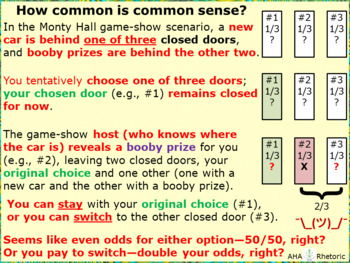Monty Hall Common Sense: maybe slow down your fast-thinking and do the math
- Gif
- Prezis
Description
This critical-thinking problem asks you to select 1 of 3 doors to possibly win a prize. After new info, you may then switch your selection. Do you make a quick, gut-level decision, or you do you do the math? This PPT-size animated GIF (5-frame, 4 seconds each, 2 cycles) can be used as a PPT slide that animates when in slide-show mode; it can also be used as a bell-ringer for any class that deals with critical thinking or conditional probability, etc. Image size 960×720 (file size 665 KB). Note 1: You can pause an animated GIF during a PowerPoint Slide Show by Right-Clicking your mouse and then later resume animation with a Left-Click. This mouse-trick works in PPT 2010, but other PPT versions may work differently. Note 2: Alt-text for this image (as in Blackboard with a limit of 100 characters): Prize in 1 of 3 options; pick 1; 1 other revealed as no-prize; stick with 1st pick or pay to switch? Used/tested and engaging with English Composition, English 101. To learn how to make such animated GIFs using PowerPoint and a free online AGIF maker, see PowerPoint slide show Animated-GIFsHow-to-Make-and-Use.


